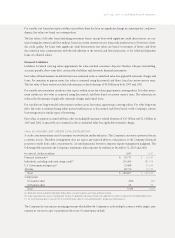American Express 2003 Annual Report Download - page 96
Download and view the complete annual report
Please find page 96 of the 2003 American Express annual report below. You can navigate through the pages in the report by either clicking on the pages listed below, or by using the keyword search tool below to find specific information within the annual report.
instruments that are designated and qualify as a hedge of a net investment in a foreign operation, the effective portion of the
gain or loss on the derivative is reported in other comprehensive income (loss) as part of the cumulative translation adjust-
ment. For derivative instruments not designated as hedging instruments, the gain or loss is recognized currently in earnings.
For the years ended December 31, 2003, 2002 and 2001, there were no significant gains or losses on derivative transactions
or portions thereof that were ineffective as hedges, excluded from the assessment of hedge effectiveness or reclassified into
earnings as a result of the discontinuance of cash flow hedges.
Cash Flow Hedges
The Company uses interest rate products, primarily swaps, to manage funding costs related to TRS’ charge card business,
as well as AEFA’s investment certificate and fixed premium product business. For its charge card products, TRS uses inter-
est rate swaps to achieve a targeted mix of fixed and floating rate funding. These interest rate swaps are used to protect the
Company from the interest rate risk that arises from short-term funding. AEFA uses interest rate products to hedge the risk
of rising interest rates on investment certificates which reset at shorter intervals than the average maturity of the investment
portfolio. Additionally, AEFA uses interest rate swaptions to hedge the risk of increasing interest rates on forecasted fixed
annuity sales.
During 2003, 2002 and 2001, the Company reclassified into earnings pretax losses of $639 million, $572 million and
$660 million, respectively. At December 31, 2003, the Company expects to reclassify $718 million of net pretax losses on
derivative instruments from accumulated other comprehensive income (loss) to earnings during the next twelve months.
These losses will be recognized in earnings during the terms of those derivatives contracts at the same time that the Com-
pany realizes the benefits of lower market rates of interest on its funding of charge card and fixed rate lending products.
Currently, the longest period of time over which the Company is hedging exposure to the variability in future cash flows is
15 years and relates to forecasted fixed annuity sales.
In addition, for selected major overseas markets, the Company uses certain foreign currency forward contracts with matu-
rities not exceeding 36 months to offset the effect of changes in foreign currency exchange rates on certain forecasted
transactions.
Fair Value Hedges
The Company is exposed to interest rate risk associated with fixed rate debt and uses interest rate swaps to convert certain
fixed rate debt to floating rate. The Company also uses interest rate swaps to hedge its firm commitments to transfer, at a
fixed rate, receivables to trusts established in connection with its asset securitizations. AEFA is exposed to interest rate risk
associated with its fixed rate corporate bond investments. AEFA enters into interest rate swaps to hedge the risk of chang-
ing interest rates as investment certificates reset at shorter intervals than the average maturity of the investment portfolio.
Hedges of Net Investment in Foreign Operations
The Company designates foreign currency derivatives as hedges of net investments in certain foreign operations. For these
hedges, unrealized gains and losses are recorded in the cumulative translation adjustment account included in other com-
prehensive income (loss), whereas the related amounts due to or from counterparties are included in other liabilities or
other assets. For the year ended December 31, 2003, the amount of losses related to the hedges included in the cumulative
translation adjustment was $44 million.
Derivatives Not Designated as Hedges
The Company has economic hedges that either do not qualify or are not designated for hedge accounting treatment under
SFAS No. 133. In addition, American Express Bank (AEB) enters into derivative contracts both to meet the needs of its
clients and, to a limited extent, for trading purposes, including taking proprietary positions.
•Foreign currency transaction exposures are economically hedged, where practical, through foreign currency con-
tracts. Foreign currency contracts involve the purchase and sale of a designated currency at an agreed upon rate for
settlement on a specified date. Such foreign currency forward contracts entered into by the Company generally
mature within one year.
(p.94_axp_ notes to consolidated financial statements)
























